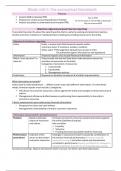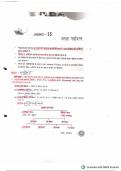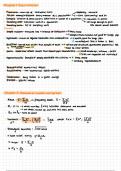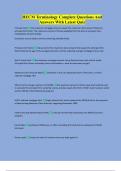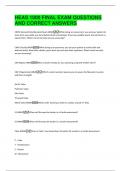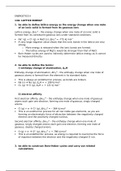Module 1: Diagnosis in Context
Ch 8: SZ Spectrum and Other Psychotic
Disorders Along the Continuum
(Nolen-Hoeksema, 2020)
Reading Question
Explain the difference between positive and negative symptoms
There are five domains of psychotic symptoms – including:
1) Four kinds of positive symptoms – i.e., delusions, hallucinations, disorganized
thoughts/speech, and disorganized or abnormal behavior – including catatonia
2) And negative symptoms – e.g., restricted emotional expression or affect
Positive Symptoms Negative Symptoms
Described as positive because they are over Labeled as negative because they involve the
expressions of unusual perceptions, thoughts, and loss of certain qualities of the person – rather
behaviors than behaviors expressed overtly
Presence of strong positive symptoms is less The presence of strong negative symptoms is
associated with poor outcome more associated with poor outcome
They tend to be transient and easier to treat They tend to be persistent and more difficult to
Medication can help overcome positive symptoms treat
Less responsive to medication
Impact of SZ Symptoms
Difficulties in functioning are linked to the (1) negative symptoms – i.e., lack of motivation
and inappropriate emotional responding – as well as to the (2) positive symptoms
,Those who show more negative symptoms – compared to mostly positive – have:
(1) Lower levels of educational attainment
(2) Less success holding job
(3) Poorer performance on cognitive tasks
(4) Poorer prognosis
Due to the unresponsiveness of negative symptoms to medication – the person may remain
chronically (1) unresponsive, (2) unmotivated, and (3) socially isolated
- Even when not acutely psychotic
Explain their place in the diagnosis 'Schizophrenia' according to the DSM-V
In order to be diagnosed with SZ – one must show two or more symptoms of psychosis:
1. At least one of which should be delusions, hallucinations, or disorganized speech =>
all of these are positive symptoms
2. These symptoms must be consistently and acutely present for at least 1 month –
referred to as the acute phase of the disorder => pointing to the transience of positive
symptoms
The individual must have some symptoms of the disorder for at least 6 months – to a degree
that impairs social or occupational functioning
1. This 6-month period must include at least 1 month of active-phase symptoms – and
may include periods of prodromal or residual symptoms
During these prodromal or residual periods – the signs of the disturbance may be manifested
(1) Only by negative symptoms => pointing towards the persistence of negative
symptoms – or by:
(2) Two or more symptoms in Criterion A – i.e., delusions, hallucinations, disorganized
speech, disorganized or catatonic behavior, or negative symptoms
Prodromal and Residual Symptoms
During the 6 months before and after the active phase – the individual may show
predominantly negative symptoms – with milder forms of positive symptoms
1) Prodromal Symptoms – i.e., before the active phase
2) Residual Symptoms – i.e., after the acute phase
, Terminology
The SZ Spectrum A set of psychotic disorders that share similarities with SZ – but are not as severe
or persistent
Hallucinations Unusual perceptual experiences – which tend to be frequent, persistent, complex,
bizarre, and often entwined with delusions
Auditory Hallucinations E.g., hearing voices, music, etc.
May consist of a voice speaking the individual’s thoughts aloud – or carrying a
running commentary on one’s behavior
May consist of a collection of voices speaking about the individual in third person
– or voices issuing commands and instructions
The voices may seem to come either from inside one’s head or from somewhere
outside
They often have a negative quality – criticizing or threatening; or telling one to
hurt themselves or others
People with SZ may talk back to the voices even as they are trying to talk to
people who are actually in the room with them
Visual Hallucinations They are often accompanied by auditory hallucinations
E.g., one may see figure of a man standing by their bedside – saying one is
damned and must die
One’s hallucinations may be consistent with their delusions
Tactile Hallucinations Involve the perception that something is happening to the outside of one’s body
E.g., bugs crawling up one’s back
Somatic Hallucinations Involve the perception that something is happening to the inside of the body
E.g., worms eating one’s intestines
Often very scary
Delusions Ideas that an individual believes are true – but are highly unlikely and often
simply impossible
Delusions cause one to be preoccupied with them
Delusional people look for evidence in support of their beliefs, attempt to
convince others of these beliefs, and take actions based on these beliefs
Delusions are highly resistant to arguments or facts that contradict them
Can be (1) simple and transient – but more often they are (2) complex and
Ch 8: SZ Spectrum and Other Psychotic
Disorders Along the Continuum
(Nolen-Hoeksema, 2020)
Reading Question
Explain the difference between positive and negative symptoms
There are five domains of psychotic symptoms – including:
1) Four kinds of positive symptoms – i.e., delusions, hallucinations, disorganized
thoughts/speech, and disorganized or abnormal behavior – including catatonia
2) And negative symptoms – e.g., restricted emotional expression or affect
Positive Symptoms Negative Symptoms
Described as positive because they are over Labeled as negative because they involve the
expressions of unusual perceptions, thoughts, and loss of certain qualities of the person – rather
behaviors than behaviors expressed overtly
Presence of strong positive symptoms is less The presence of strong negative symptoms is
associated with poor outcome more associated with poor outcome
They tend to be transient and easier to treat They tend to be persistent and more difficult to
Medication can help overcome positive symptoms treat
Less responsive to medication
Impact of SZ Symptoms
Difficulties in functioning are linked to the (1) negative symptoms – i.e., lack of motivation
and inappropriate emotional responding – as well as to the (2) positive symptoms
,Those who show more negative symptoms – compared to mostly positive – have:
(1) Lower levels of educational attainment
(2) Less success holding job
(3) Poorer performance on cognitive tasks
(4) Poorer prognosis
Due to the unresponsiveness of negative symptoms to medication – the person may remain
chronically (1) unresponsive, (2) unmotivated, and (3) socially isolated
- Even when not acutely psychotic
Explain their place in the diagnosis 'Schizophrenia' according to the DSM-V
In order to be diagnosed with SZ – one must show two or more symptoms of psychosis:
1. At least one of which should be delusions, hallucinations, or disorganized speech =>
all of these are positive symptoms
2. These symptoms must be consistently and acutely present for at least 1 month –
referred to as the acute phase of the disorder => pointing to the transience of positive
symptoms
The individual must have some symptoms of the disorder for at least 6 months – to a degree
that impairs social or occupational functioning
1. This 6-month period must include at least 1 month of active-phase symptoms – and
may include periods of prodromal or residual symptoms
During these prodromal or residual periods – the signs of the disturbance may be manifested
(1) Only by negative symptoms => pointing towards the persistence of negative
symptoms – or by:
(2) Two or more symptoms in Criterion A – i.e., delusions, hallucinations, disorganized
speech, disorganized or catatonic behavior, or negative symptoms
Prodromal and Residual Symptoms
During the 6 months before and after the active phase – the individual may show
predominantly negative symptoms – with milder forms of positive symptoms
1) Prodromal Symptoms – i.e., before the active phase
2) Residual Symptoms – i.e., after the acute phase
, Terminology
The SZ Spectrum A set of psychotic disorders that share similarities with SZ – but are not as severe
or persistent
Hallucinations Unusual perceptual experiences – which tend to be frequent, persistent, complex,
bizarre, and often entwined with delusions
Auditory Hallucinations E.g., hearing voices, music, etc.
May consist of a voice speaking the individual’s thoughts aloud – or carrying a
running commentary on one’s behavior
May consist of a collection of voices speaking about the individual in third person
– or voices issuing commands and instructions
The voices may seem to come either from inside one’s head or from somewhere
outside
They often have a negative quality – criticizing or threatening; or telling one to
hurt themselves or others
People with SZ may talk back to the voices even as they are trying to talk to
people who are actually in the room with them
Visual Hallucinations They are often accompanied by auditory hallucinations
E.g., one may see figure of a man standing by their bedside – saying one is
damned and must die
One’s hallucinations may be consistent with their delusions
Tactile Hallucinations Involve the perception that something is happening to the outside of one’s body
E.g., bugs crawling up one’s back
Somatic Hallucinations Involve the perception that something is happening to the inside of the body
E.g., worms eating one’s intestines
Often very scary
Delusions Ideas that an individual believes are true – but are highly unlikely and often
simply impossible
Delusions cause one to be preoccupied with them
Delusional people look for evidence in support of their beliefs, attempt to
convince others of these beliefs, and take actions based on these beliefs
Delusions are highly resistant to arguments or facts that contradict them
Can be (1) simple and transient – but more often they are (2) complex and


